Designing a National E-Government System: An Information-Centric View
VerifiedAdded on 2023/04/11
|17
|2515
|479
Report
AI Summary
This report provides an overview of information-centric design for national-level E-Government systems, highlighting the role of Enterprise Information Architecture Reference Architecture (EIA RA) and Information and Communication Technology (ICT) in designing and implementing effective E-Government solutions. It discusses the Information Maturity Model (IMM) and its various functions (Aware, Developing, Practicing, Optimizing, and Leading) and their relevance to the E-Government system. The report also explores the benefits of IT-enabled government systems and the importance of ICT in strategic planning, data management, and citizen feedback. It also touches upon E-Government maturity stages and the transformation process, concluding with recommendations for leveraging ICT to improve government performance and service delivery.
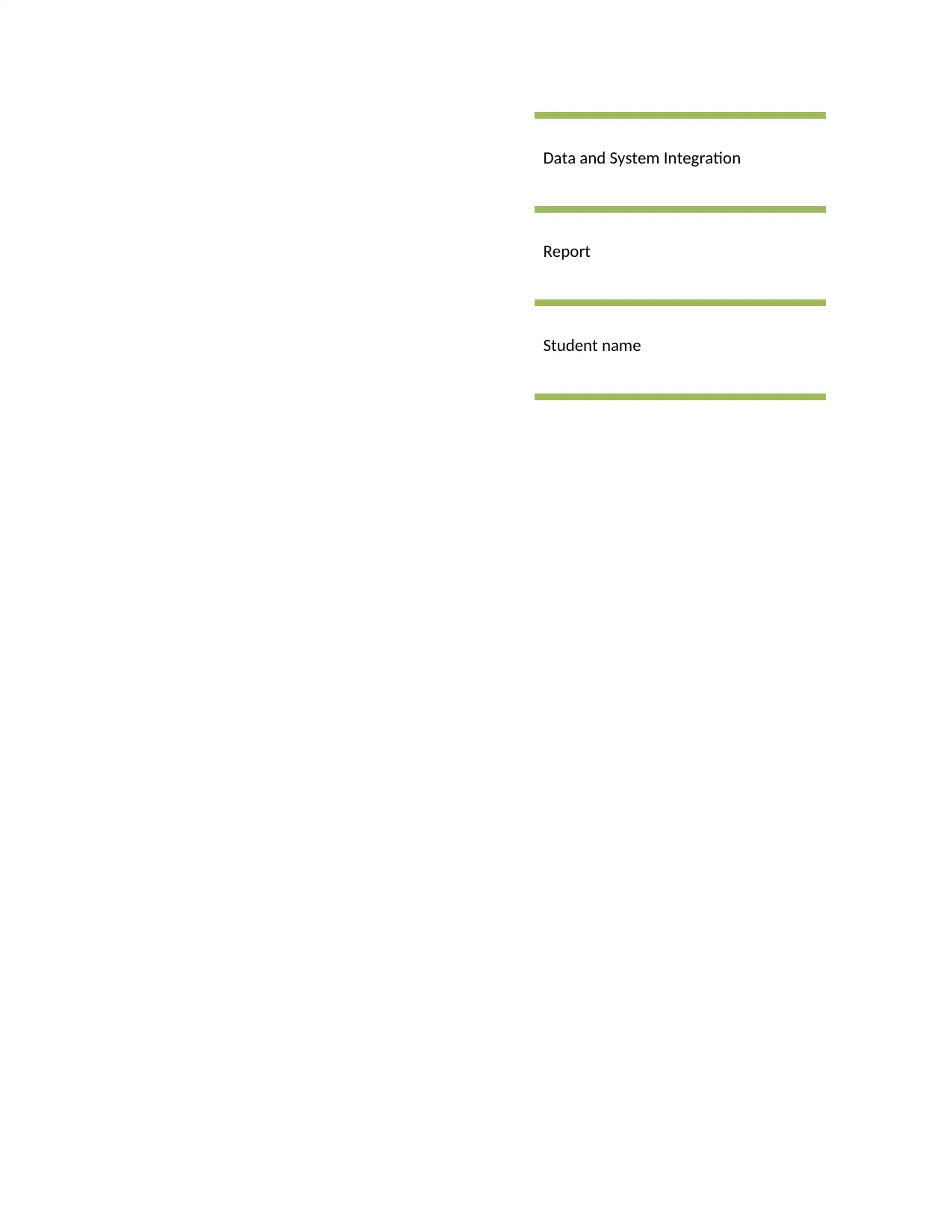
Data and System Integration
Report
Student name
Report
Student name
Paraphrase This Document
Need a fresh take? Get an instant paraphrase of this document with our AI Paraphraser

Table of Contents
Executive Summary.........................................................................................................................2
Introduction.....................................................................................................................................3
Information-centric Design..............................................................................................................3
Function 1.....................................................................................................................................6
Function 2.....................................................................................................................................6
Enterprise Information Architecture Reference Architecture (EIA RA):.........................................7
Conclusion and recommendations................................................................................................13
References.....................................................................................................................................15
1 | P a g e
Executive Summary.........................................................................................................................2
Introduction.....................................................................................................................................3
Information-centric Design..............................................................................................................3
Function 1.....................................................................................................................................6
Function 2.....................................................................................................................................6
Enterprise Information Architecture Reference Architecture (EIA RA):.........................................7
Conclusion and recommendations................................................................................................13
References.....................................................................................................................................15
1 | P a g e
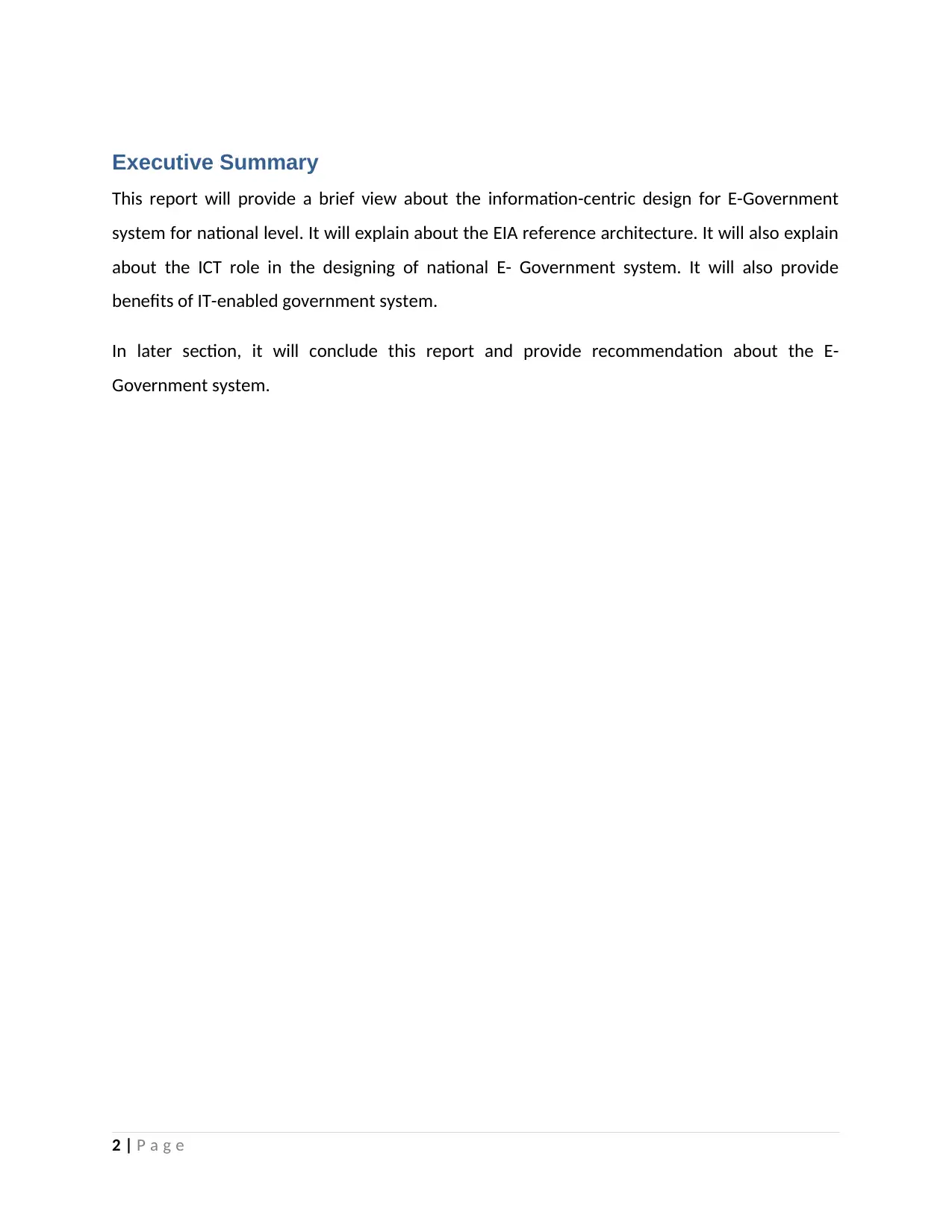
Executive Summary
This report will provide a brief view about the information-centric design for E-Government
system for national level. It will explain about the EIA reference architecture. It will also explain
about the ICT role in the designing of national E- Government system. It will also provide
benefits of IT-enabled government system.
In later section, it will conclude this report and provide recommendation about the E-
Government system.
2 | P a g e
This report will provide a brief view about the information-centric design for E-Government
system for national level. It will explain about the EIA reference architecture. It will also explain
about the ICT role in the designing of national E- Government system. It will also provide
benefits of IT-enabled government system.
In later section, it will conclude this report and provide recommendation about the E-
Government system.
2 | P a g e
⊘ This is a preview!⊘
Do you want full access?
Subscribe today to unlock all pages.

Trusted by 1+ million students worldwide
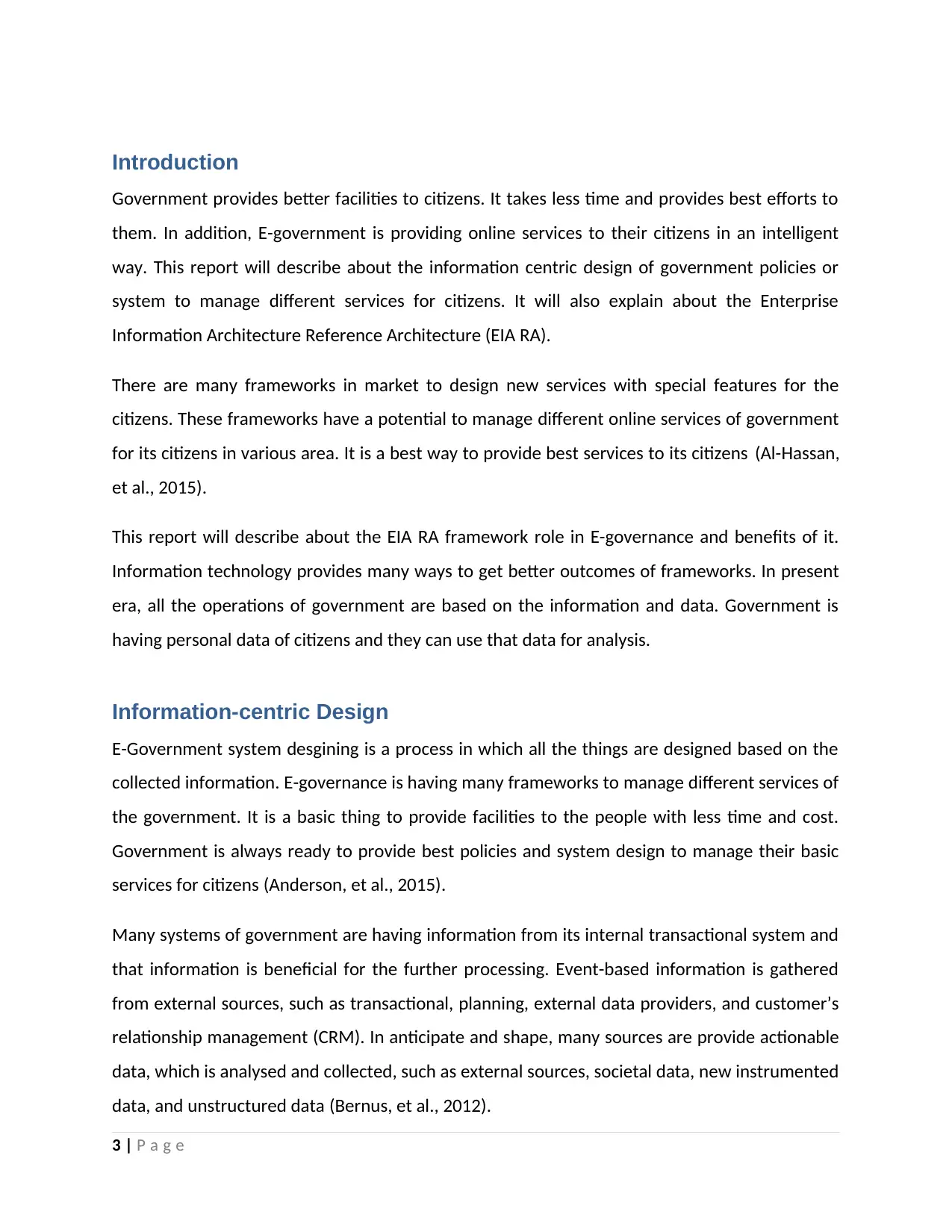
Introduction
Government provides better facilities to citizens. It takes less time and provides best efforts to
them. In addition, E-government is providing online services to their citizens in an intelligent
way. This report will describe about the information centric design of government policies or
system to manage different services for citizens. It will also explain about the Enterprise
Information Architecture Reference Architecture (EIA RA).
There are many frameworks in market to design new services with special features for the
citizens. These frameworks have a potential to manage different online services of government
for its citizens in various area. It is a best way to provide best services to its citizens (Al-Hassan,
et al., 2015).
This report will describe about the EIA RA framework role in E-governance and benefits of it.
Information technology provides many ways to get better outcomes of frameworks. In present
era, all the operations of government are based on the information and data. Government is
having personal data of citizens and they can use that data for analysis.
Information-centric Design
E-Government system desgining is a process in which all the things are designed based on the
collected information. E-governance is having many frameworks to manage different services of
the government. It is a basic thing to provide facilities to the people with less time and cost.
Government is always ready to provide best policies and system design to manage their basic
services for citizens (Anderson, et al., 2015).
Many systems of government are having information from its internal transactional system and
that information is beneficial for the further processing. Event-based information is gathered
from external sources, such as transactional, planning, external data providers, and customer’s
relationship management (CRM). In anticipate and shape, many sources are provide actionable
data, which is analysed and collected, such as external sources, societal data, new instrumented
data, and unstructured data (Bernus, et al., 2012).
3 | P a g e
Government provides better facilities to citizens. It takes less time and provides best efforts to
them. In addition, E-government is providing online services to their citizens in an intelligent
way. This report will describe about the information centric design of government policies or
system to manage different services for citizens. It will also explain about the Enterprise
Information Architecture Reference Architecture (EIA RA).
There are many frameworks in market to design new services with special features for the
citizens. These frameworks have a potential to manage different online services of government
for its citizens in various area. It is a best way to provide best services to its citizens (Al-Hassan,
et al., 2015).
This report will describe about the EIA RA framework role in E-governance and benefits of it.
Information technology provides many ways to get better outcomes of frameworks. In present
era, all the operations of government are based on the information and data. Government is
having personal data of citizens and they can use that data for analysis.
Information-centric Design
E-Government system desgining is a process in which all the things are designed based on the
collected information. E-governance is having many frameworks to manage different services of
the government. It is a basic thing to provide facilities to the people with less time and cost.
Government is always ready to provide best policies and system design to manage their basic
services for citizens (Anderson, et al., 2015).
Many systems of government are having information from its internal transactional system and
that information is beneficial for the further processing. Event-based information is gathered
from external sources, such as transactional, planning, external data providers, and customer’s
relationship management (CRM). In anticipate and shape, many sources are provide actionable
data, which is analysed and collected, such as external sources, societal data, new instrumented
data, and unstructured data (Bernus, et al., 2012).
3 | P a g e
Paraphrase This Document
Need a fresh take? Get an instant paraphrase of this document with our AI Paraphraser
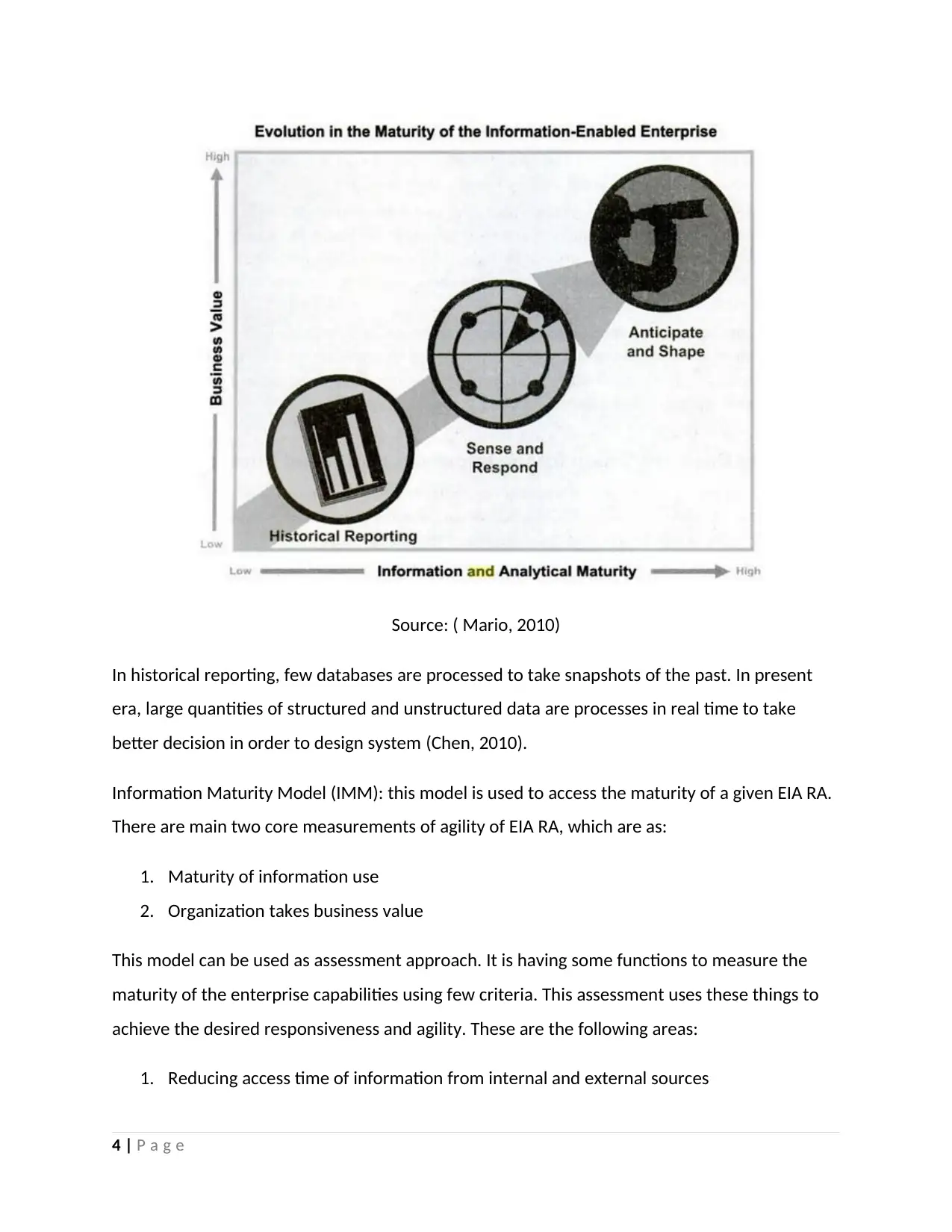
Source: ( Mario, 2010)
In historical reporting, few databases are processed to take snapshots of the past. In present
era, large quantities of structured and unstructured data are processes in real time to take
better decision in order to design system (Chen, 2010).
Information Maturity Model (IMM): this model is used to access the maturity of a given EIA RA.
There are main two core measurements of agility of EIA RA, which are as:
1. Maturity of information use
2. Organization takes business value
This model can be used as assessment approach. It is having some functions to measure the
maturity of the enterprise capabilities using few criteria. This assessment uses these things to
achieve the desired responsiveness and agility. These are the following areas:
1. Reducing access time of information from internal and external sources
4 | P a g e
In historical reporting, few databases are processed to take snapshots of the past. In present
era, large quantities of structured and unstructured data are processes in real time to take
better decision in order to design system (Chen, 2010).
Information Maturity Model (IMM): this model is used to access the maturity of a given EIA RA.
There are main two core measurements of agility of EIA RA, which are as:
1. Maturity of information use
2. Organization takes business value
This model can be used as assessment approach. It is having some functions to measure the
maturity of the enterprise capabilities using few criteria. This assessment uses these things to
achieve the desired responsiveness and agility. These are the following areas:
1. Reducing access time of information from internal and external sources
4 | P a g e
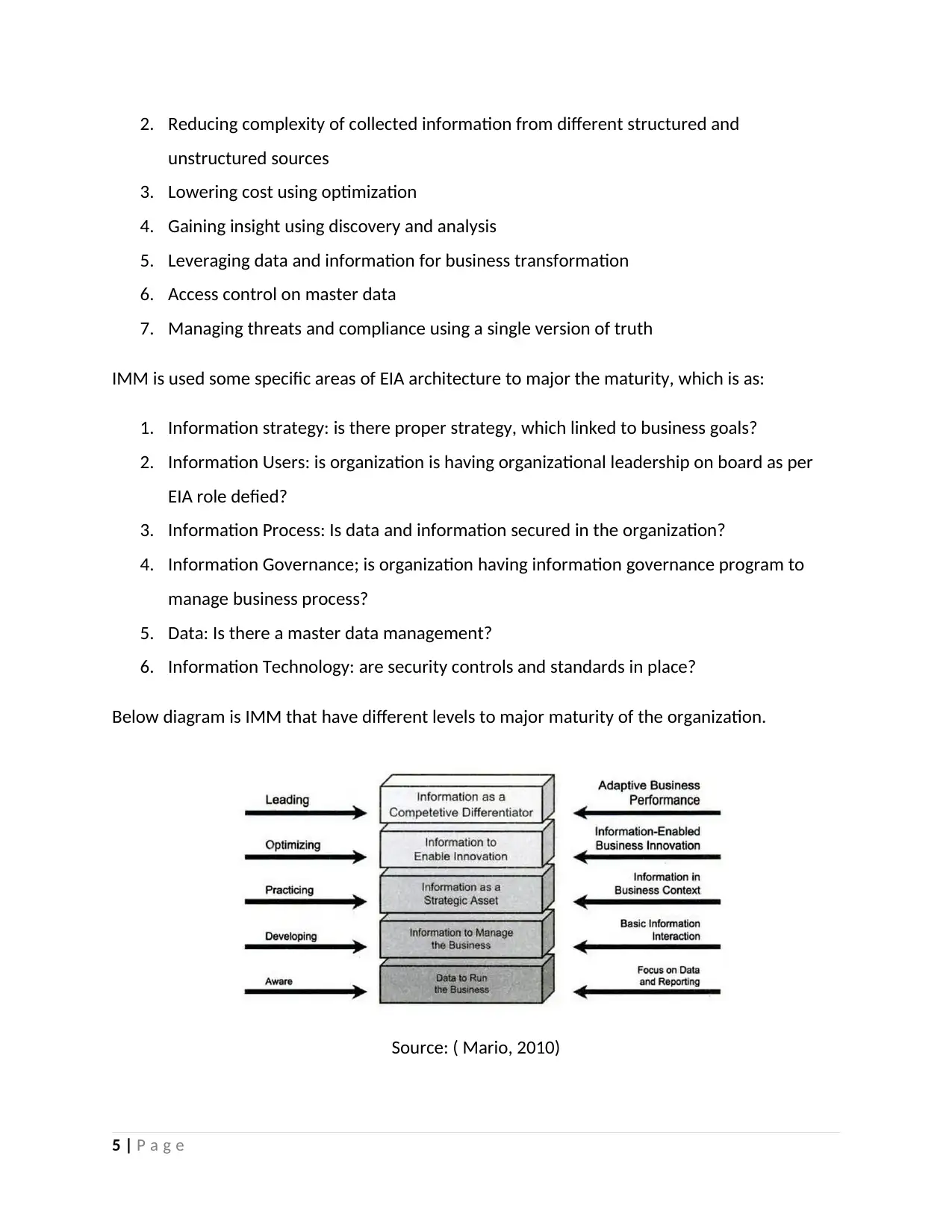
2. Reducing complexity of collected information from different structured and
unstructured sources
3. Lowering cost using optimization
4. Gaining insight using discovery and analysis
5. Leveraging data and information for business transformation
6. Access control on master data
7. Managing threats and compliance using a single version of truth
IMM is used some specific areas of EIA architecture to major the maturity, which is as:
1. Information strategy: is there proper strategy, which linked to business goals?
2. Information Users: is organization is having organizational leadership on board as per
EIA role defied?
3. Information Process: Is data and information secured in the organization?
4. Information Governance; is organization having information governance program to
manage business process?
5. Data: Is there a master data management?
6. Information Technology: are security controls and standards in place?
Below diagram is IMM that have different levels to major maturity of the organization.
Source: ( Mario, 2010)
5 | P a g e
unstructured sources
3. Lowering cost using optimization
4. Gaining insight using discovery and analysis
5. Leveraging data and information for business transformation
6. Access control on master data
7. Managing threats and compliance using a single version of truth
IMM is used some specific areas of EIA architecture to major the maturity, which is as:
1. Information strategy: is there proper strategy, which linked to business goals?
2. Information Users: is organization is having organizational leadership on board as per
EIA role defied?
3. Information Process: Is data and information secured in the organization?
4. Information Governance; is organization having information governance program to
manage business process?
5. Data: Is there a master data management?
6. Information Technology: are security controls and standards in place?
Below diagram is IMM that have different levels to major maturity of the organization.
Source: ( Mario, 2010)
5 | P a g e
⊘ This is a preview!⊘
Do you want full access?
Subscribe today to unlock all pages.

Trusted by 1+ million students worldwide
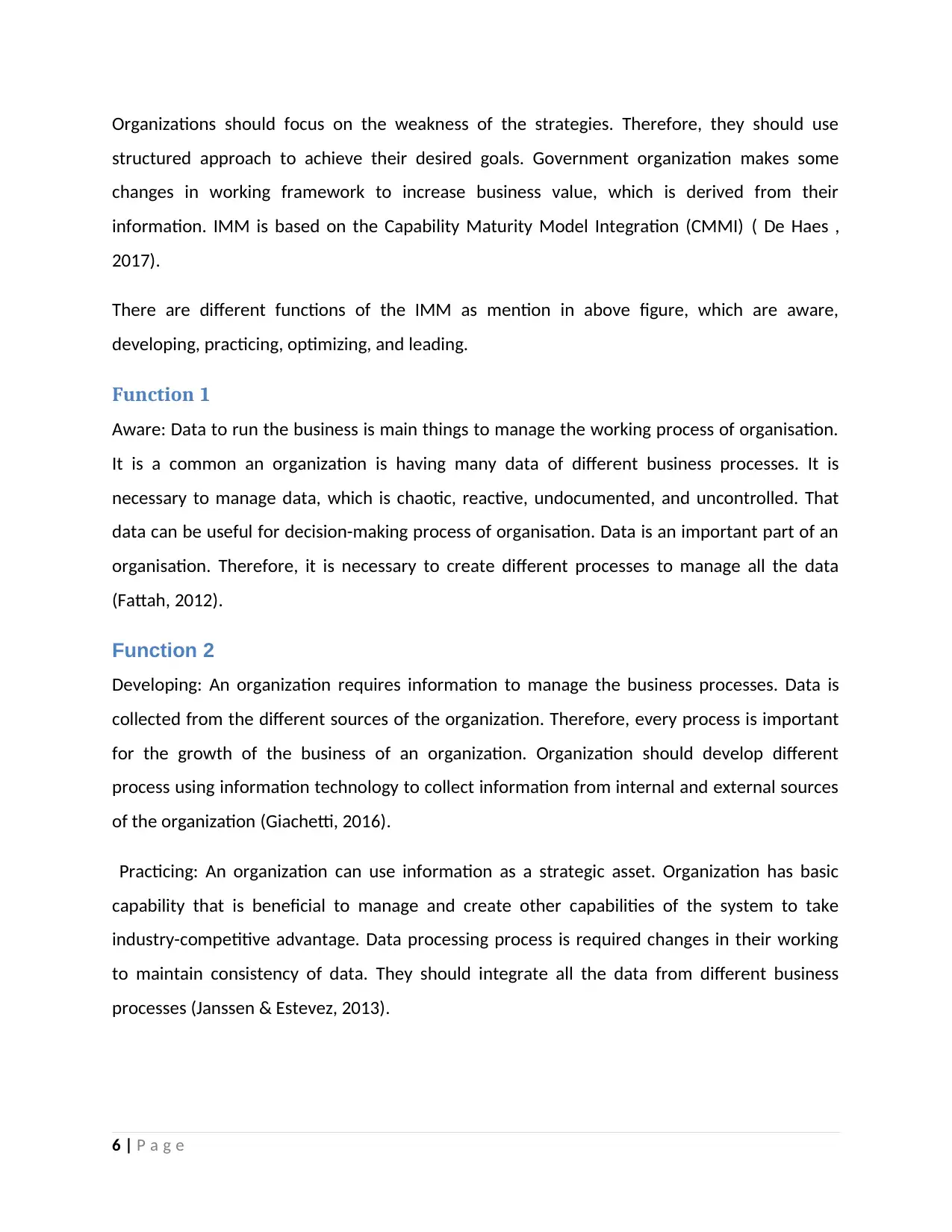
Organizations should focus on the weakness of the strategies. Therefore, they should use
structured approach to achieve their desired goals. Government organization makes some
changes in working framework to increase business value, which is derived from their
information. IMM is based on the Capability Maturity Model Integration (CMMI) ( De Haes ,
2017).
There are different functions of the IMM as mention in above figure, which are aware,
developing, practicing, optimizing, and leading.
Function 1
Aware: Data to run the business is main things to manage the working process of organisation.
It is a common an organization is having many data of different business processes. It is
necessary to manage data, which is chaotic, reactive, undocumented, and uncontrolled. That
data can be useful for decision-making process of organisation. Data is an important part of an
organisation. Therefore, it is necessary to create different processes to manage all the data
(Fattah, 2012).
Function 2
Developing: An organization requires information to manage the business processes. Data is
collected from the different sources of the organization. Therefore, every process is important
for the growth of the business of an organization. Organization should develop different
process using information technology to collect information from internal and external sources
of the organization (Giachetti, 2016).
Practicing: An organization can use information as a strategic asset. Organization has basic
capability that is beneficial to manage and create other capabilities of the system to take
industry-competitive advantage. Data processing process is required changes in their working
to maintain consistency of data. They should integrate all the data from different business
processes (Janssen & Estevez, 2013).
6 | P a g e
structured approach to achieve their desired goals. Government organization makes some
changes in working framework to increase business value, which is derived from their
information. IMM is based on the Capability Maturity Model Integration (CMMI) ( De Haes ,
2017).
There are different functions of the IMM as mention in above figure, which are aware,
developing, practicing, optimizing, and leading.
Function 1
Aware: Data to run the business is main things to manage the working process of organisation.
It is a common an organization is having many data of different business processes. It is
necessary to manage data, which is chaotic, reactive, undocumented, and uncontrolled. That
data can be useful for decision-making process of organisation. Data is an important part of an
organisation. Therefore, it is necessary to create different processes to manage all the data
(Fattah, 2012).
Function 2
Developing: An organization requires information to manage the business processes. Data is
collected from the different sources of the organization. Therefore, every process is important
for the growth of the business of an organization. Organization should develop different
process using information technology to collect information from internal and external sources
of the organization (Giachetti, 2016).
Practicing: An organization can use information as a strategic asset. Organization has basic
capability that is beneficial to manage and create other capabilities of the system to take
industry-competitive advantage. Data processing process is required changes in their working
to maintain consistency of data. They should integrate all the data from different business
processes (Janssen & Estevez, 2013).
6 | P a g e
Paraphrase This Document
Need a fresh take? Get an instant paraphrase of this document with our AI Paraphraser
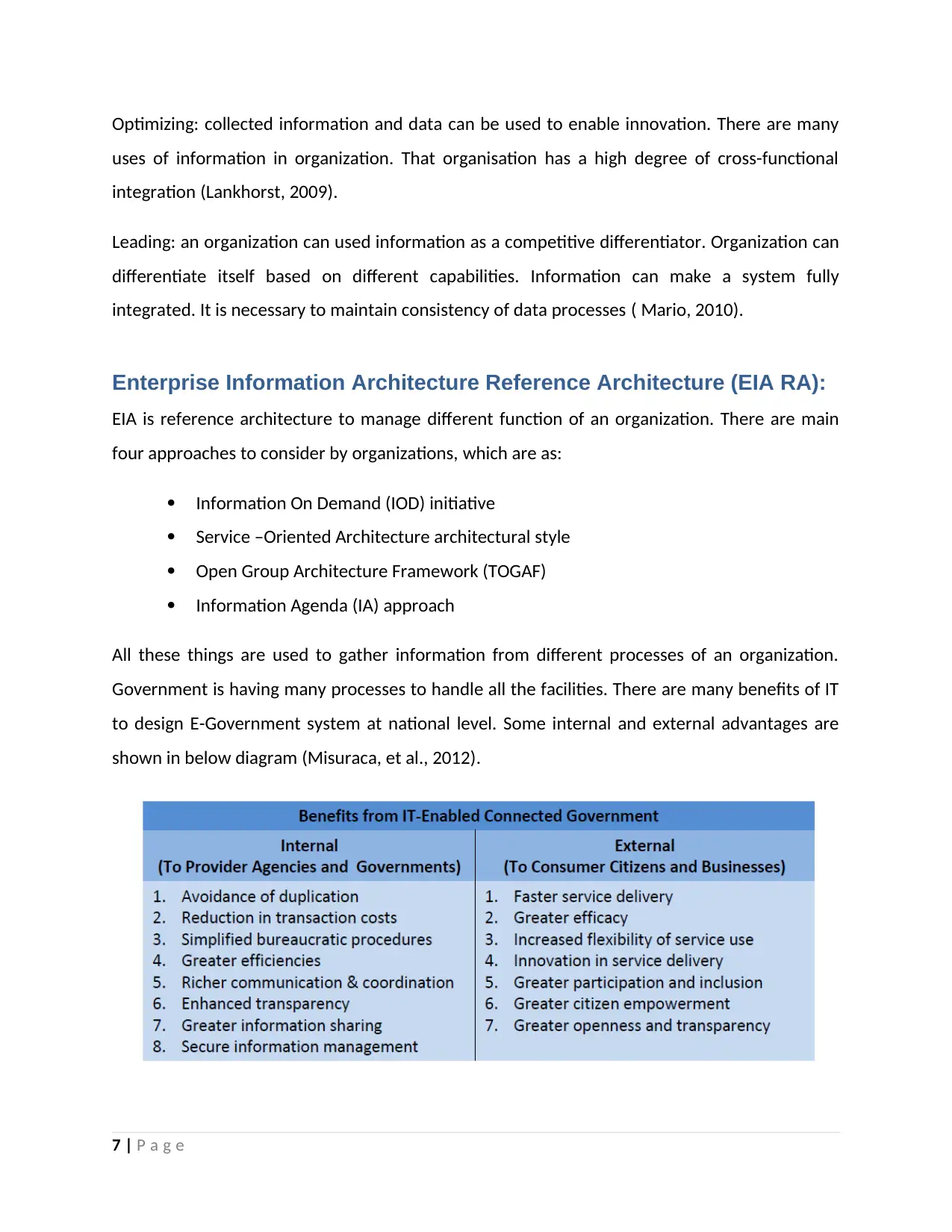
Optimizing: collected information and data can be used to enable innovation. There are many
uses of information in organization. That organisation has a high degree of cross-functional
integration (Lankhorst, 2009).
Leading: an organization can used information as a competitive differentiator. Organization can
differentiate itself based on different capabilities. Information can make a system fully
integrated. It is necessary to maintain consistency of data processes ( Mario, 2010).
Enterprise Information Architecture Reference Architecture (EIA RA):
EIA is reference architecture to manage different function of an organization. There are main
four approaches to consider by organizations, which are as:
Information On Demand (IOD) initiative
Service –Oriented Architecture architectural style
Open Group Architecture Framework (TOGAF)
Information Agenda (IA) approach
All these things are used to gather information from different processes of an organization.
Government is having many processes to handle all the facilities. There are many benefits of IT
to design E-Government system at national level. Some internal and external advantages are
shown in below diagram (Misuraca, et al., 2012).
7 | P a g e
uses of information in organization. That organisation has a high degree of cross-functional
integration (Lankhorst, 2009).
Leading: an organization can used information as a competitive differentiator. Organization can
differentiate itself based on different capabilities. Information can make a system fully
integrated. It is necessary to maintain consistency of data processes ( Mario, 2010).
Enterprise Information Architecture Reference Architecture (EIA RA):
EIA is reference architecture to manage different function of an organization. There are main
four approaches to consider by organizations, which are as:
Information On Demand (IOD) initiative
Service –Oriented Architecture architectural style
Open Group Architecture Framework (TOGAF)
Information Agenda (IA) approach
All these things are used to gather information from different processes of an organization.
Government is having many processes to handle all the facilities. There are many benefits of IT
to design E-Government system at national level. Some internal and external advantages are
shown in below diagram (Misuraca, et al., 2012).
7 | P a g e

Source: (Saha, 2010)
Enterprise Lifecycle with Architecture: Many factors are affecting the progress of government.
Information Communication and Technology (ICT) is highly affecting the progress of a
government (Nam & Pardo, 2011).
Source: (Saha, 2010)
Enterprise life cycle is having four parts, which are environmental drivers, strategic planning,
enterprise Architecture planning, implementation planning, and Feedback. In case of
development of national E-Government system, ICT is providing a huge help to decide new
8 | P a g e
Enterprise Lifecycle with Architecture: Many factors are affecting the progress of government.
Information Communication and Technology (ICT) is highly affecting the progress of a
government (Nam & Pardo, 2011).
Source: (Saha, 2010)
Enterprise life cycle is having four parts, which are environmental drivers, strategic planning,
enterprise Architecture planning, implementation planning, and Feedback. In case of
development of national E-Government system, ICT is providing a huge help to decide new
8 | P a g e
⊘ This is a preview!⊘
Do you want full access?
Subscribe today to unlock all pages.

Trusted by 1+ million students worldwide
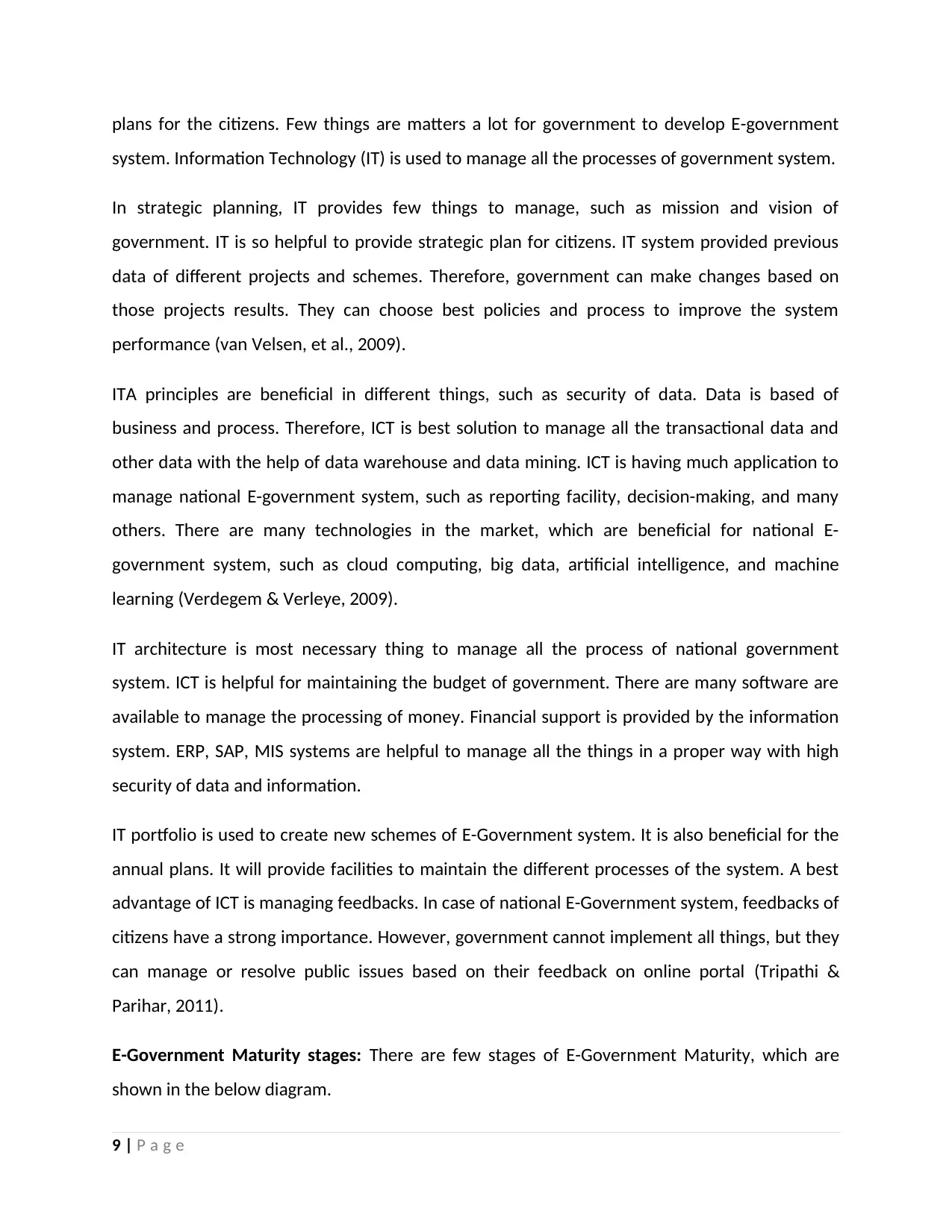
plans for the citizens. Few things are matters a lot for government to develop E-government
system. Information Technology (IT) is used to manage all the processes of government system.
In strategic planning, IT provides few things to manage, such as mission and vision of
government. IT is so helpful to provide strategic plan for citizens. IT system provided previous
data of different projects and schemes. Therefore, government can make changes based on
those projects results. They can choose best policies and process to improve the system
performance (van Velsen, et al., 2009).
ITA principles are beneficial in different things, such as security of data. Data is based of
business and process. Therefore, ICT is best solution to manage all the transactional data and
other data with the help of data warehouse and data mining. ICT is having much application to
manage national E-government system, such as reporting facility, decision-making, and many
others. There are many technologies in the market, which are beneficial for national E-
government system, such as cloud computing, big data, artificial intelligence, and machine
learning (Verdegem & Verleye, 2009).
IT architecture is most necessary thing to manage all the process of national government
system. ICT is helpful for maintaining the budget of government. There are many software are
available to manage the processing of money. Financial support is provided by the information
system. ERP, SAP, MIS systems are helpful to manage all the things in a proper way with high
security of data and information.
IT portfolio is used to create new schemes of E-Government system. It is also beneficial for the
annual plans. It will provide facilities to maintain the different processes of the system. A best
advantage of ICT is managing feedbacks. In case of national E-Government system, feedbacks of
citizens have a strong importance. However, government cannot implement all things, but they
can manage or resolve public issues based on their feedback on online portal (Tripathi &
Parihar, 2011).
E-Government Maturity stages: There are few stages of E-Government Maturity, which are
shown in the below diagram.
9 | P a g e
system. Information Technology (IT) is used to manage all the processes of government system.
In strategic planning, IT provides few things to manage, such as mission and vision of
government. IT is so helpful to provide strategic plan for citizens. IT system provided previous
data of different projects and schemes. Therefore, government can make changes based on
those projects results. They can choose best policies and process to improve the system
performance (van Velsen, et al., 2009).
ITA principles are beneficial in different things, such as security of data. Data is based of
business and process. Therefore, ICT is best solution to manage all the transactional data and
other data with the help of data warehouse and data mining. ICT is having much application to
manage national E-government system, such as reporting facility, decision-making, and many
others. There are many technologies in the market, which are beneficial for national E-
government system, such as cloud computing, big data, artificial intelligence, and machine
learning (Verdegem & Verleye, 2009).
IT architecture is most necessary thing to manage all the process of national government
system. ICT is helpful for maintaining the budget of government. There are many software are
available to manage the processing of money. Financial support is provided by the information
system. ERP, SAP, MIS systems are helpful to manage all the things in a proper way with high
security of data and information.
IT portfolio is used to create new schemes of E-Government system. It is also beneficial for the
annual plans. It will provide facilities to maintain the different processes of the system. A best
advantage of ICT is managing feedbacks. In case of national E-Government system, feedbacks of
citizens have a strong importance. However, government cannot implement all things, but they
can manage or resolve public issues based on their feedback on online portal (Tripathi &
Parihar, 2011).
E-Government Maturity stages: There are few stages of E-Government Maturity, which are
shown in the below diagram.
9 | P a g e
Paraphrase This Document
Need a fresh take? Get an instant paraphrase of this document with our AI Paraphraser
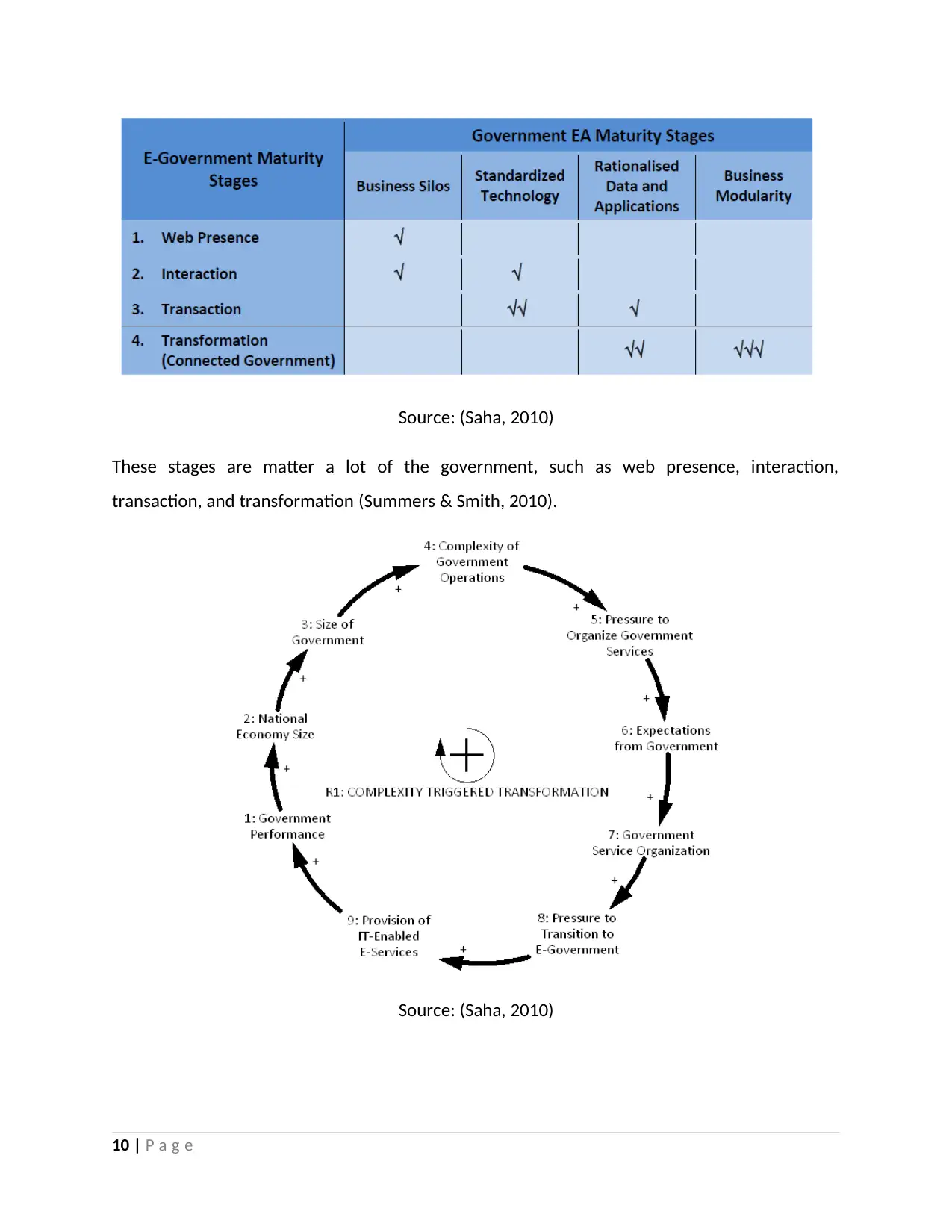
Source: (Saha, 2010)
These stages are matter a lot of the government, such as web presence, interaction,
transaction, and transformation (Summers & Smith, 2010).
Source: (Saha, 2010)
10 | P a g e
These stages are matter a lot of the government, such as web presence, interaction,
transaction, and transformation (Summers & Smith, 2010).
Source: (Saha, 2010)
10 | P a g e
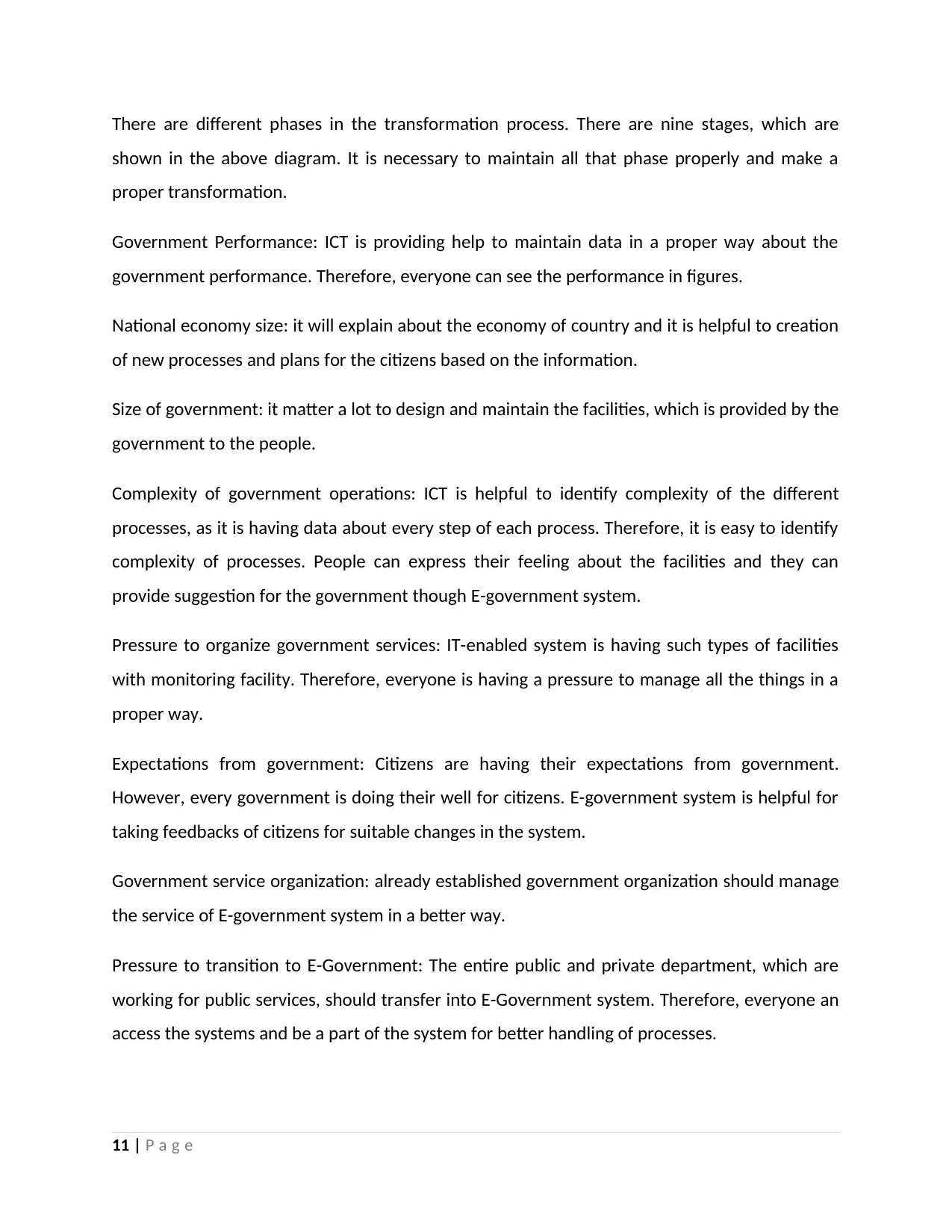
There are different phases in the transformation process. There are nine stages, which are
shown in the above diagram. It is necessary to maintain all that phase properly and make a
proper transformation.
Government Performance: ICT is providing help to maintain data in a proper way about the
government performance. Therefore, everyone can see the performance in figures.
National economy size: it will explain about the economy of country and it is helpful to creation
of new processes and plans for the citizens based on the information.
Size of government: it matter a lot to design and maintain the facilities, which is provided by the
government to the people.
Complexity of government operations: ICT is helpful to identify complexity of the different
processes, as it is having data about every step of each process. Therefore, it is easy to identify
complexity of processes. People can express their feeling about the facilities and they can
provide suggestion for the government though E-government system.
Pressure to organize government services: IT-enabled system is having such types of facilities
with monitoring facility. Therefore, everyone is having a pressure to manage all the things in a
proper way.
Expectations from government: Citizens are having their expectations from government.
However, every government is doing their well for citizens. E-government system is helpful for
taking feedbacks of citizens for suitable changes in the system.
Government service organization: already established government organization should manage
the service of E-government system in a better way.
Pressure to transition to E-Government: The entire public and private department, which are
working for public services, should transfer into E-Government system. Therefore, everyone an
access the systems and be a part of the system for better handling of processes.
11 | P a g e
shown in the above diagram. It is necessary to maintain all that phase properly and make a
proper transformation.
Government Performance: ICT is providing help to maintain data in a proper way about the
government performance. Therefore, everyone can see the performance in figures.
National economy size: it will explain about the economy of country and it is helpful to creation
of new processes and plans for the citizens based on the information.
Size of government: it matter a lot to design and maintain the facilities, which is provided by the
government to the people.
Complexity of government operations: ICT is helpful to identify complexity of the different
processes, as it is having data about every step of each process. Therefore, it is easy to identify
complexity of processes. People can express their feeling about the facilities and they can
provide suggestion for the government though E-government system.
Pressure to organize government services: IT-enabled system is having such types of facilities
with monitoring facility. Therefore, everyone is having a pressure to manage all the things in a
proper way.
Expectations from government: Citizens are having their expectations from government.
However, every government is doing their well for citizens. E-government system is helpful for
taking feedbacks of citizens for suitable changes in the system.
Government service organization: already established government organization should manage
the service of E-government system in a better way.
Pressure to transition to E-Government: The entire public and private department, which are
working for public services, should transfer into E-Government system. Therefore, everyone an
access the systems and be a part of the system for better handling of processes.
11 | P a g e
⊘ This is a preview!⊘
Do you want full access?
Subscribe today to unlock all pages.

Trusted by 1+ million students worldwide
1 out of 17
Related Documents
Your All-in-One AI-Powered Toolkit for Academic Success.
+13062052269
info@desklib.com
Available 24*7 on WhatsApp / Email
![[object Object]](/_next/static/media/star-bottom.7253800d.svg)
Unlock your academic potential
Copyright © 2020–2025 A2Z Services. All Rights Reserved. Developed and managed by ZUCOL.





